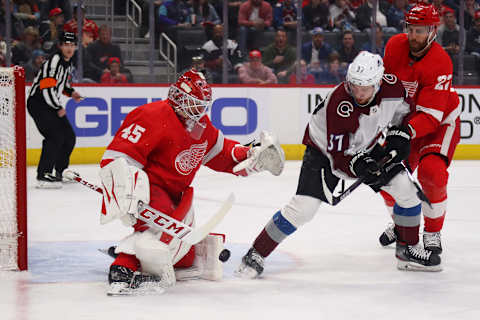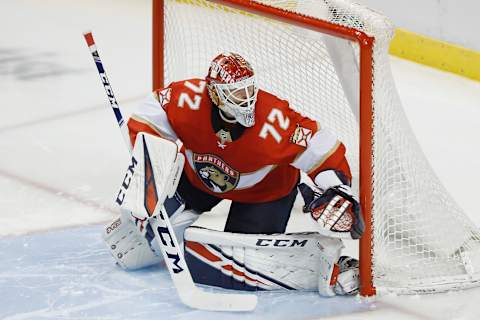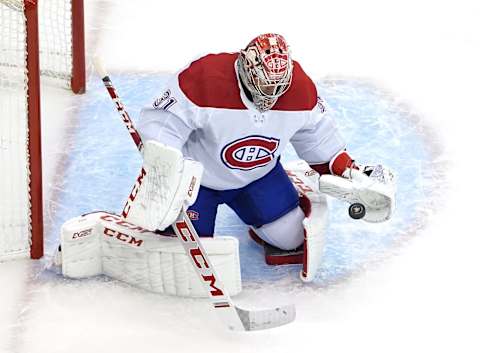NHL: Ranking the starting goaltenders of the Atlantic Division


The NHL’s Atlantic Division features four former Vezina Trophy winners.
The Atlantic Division is filled with established NHL goaltenders and several younger netminders looking to find a home. But at the top, you arguably have four of the top ten goaltenders on the league, making this list extremely subjective.
As a reminder, these are the statistics I will be using to help determine the rankings for the Atlantic Division.
- GAA (Goals Against Average)
- SV% (Save Percentage)
- QS% (Quality Start Percentage)
- GSAA (Goals Saved Above Average)
- RBS (Really Bad Starts)
- HDSV% (High Danger Save Percentage)
- HDGAA (High Danger Goals Against Average)
Last season’s President Trophy winner (Boston Bruins) and Stanley Cup champions (Tampa Bay Lightning) both hailed in the Atlantic. In an extremely top-heavy division, the standings are a fair indication of the goaltenders each team possesses. Without further delay, here are my rankings for the starting goaltenders of the Atlantic.
. Jonathan Bernier. 8. player. 72. .
Considering how poor the Detroit Red Wings were in 2019-20, Jonathan Bernier held up fairly well in goal. I was close to putting him one spot higher, but with Detroit likely to be poor defensively again and for his role to be split with newly signed Thomas Greiss, Bernier comes in the eighth spot.
He finished last season with a 15-22-3 record, a 2.95 GAA, and a .907 SV%. His QS% (41.5) and GSAA (-3.66) were low, but considering what was going on in front of him, Bernier is hardly accountable. The 32-year old miraculously only had five RBS for Detroit, a category that should be less in 2021 due to some offseason improvements to the roster.
Bernier was just ok in high danger situation, finishing last season with a 1.74 HDGAA and a .808 HDSV%. It was a season to forget for both the Red Wings and Bernier, but there were glimpses of brilliance that the netminder will like to carry over to next year.

91. . . . Matt Murray. 7. player
After backstopping the Penguins to two Stanley Cups, Matt Murray saw his role in Pittsburgh taken over by Tristan Jarry. A subsequent trade to Ottawa resulted, and now Murray will take over the Senators starting job after signing a four-year extension. If Murray’s play continues from last year, Ottawa’s faith in the 26-year old will surely be tested.
Despite a winning record of 20-11-5, Murray posted a career-low .899 SV% and a 2.87 GAA, the second-highest mark of his career. The Ontario native posted an abysmal GSAA of -11.60 and an equally as poor QS% of 42.1.
Murray did do a respectable job in high danger scenarios, posting a .816 HDSV% and a 1.50 HDGAA, but those numbers didn’t change the fact that eight of his 38 starts qualified as RBS. Hopefully, the change of scenery can reinvigorate the Stanley Cup winner, who needs a bounce-back year for Ottawa.
6. player. 12. . . . Linus Ullmark
Linus Ullmark may be the least recognized name in this division, but the Swedish goaltender was excellent for Buffalo last year. He went 17-14-3 with a 2.69 GAA and a .915 SV% while earning the rest of the organization and succeeding Carter Hutton as the starting netminder.
Ullmark has been inconsistent over his NHL career but made massive strides in 2019-20 when he vastly improved his numbers from the prior year. He recorded a QS% of 55.9 while only having two RBS, helping increase his GSAA to 5.39.
Ullmark struggled in high-danger chances, which he has to improve upon if he wants to remain a number one goaltender in the NHL. He had an HDSV% of just .785, which ranked 62nd, and an HDGAA of 1.75, which ranked 58th. The 27-year old has potential but is still a work in progress for Buffalo.

player. 97. . . . Sergei Bobrovsky. 5
The first person to tell you that 2019-20 was a horrid season for Sergei Bobrovsky would be Bobrovsky himself. After signing a massive contract to backstop the Florida Panthers, Bobrovsky failed to live up to expectations in his first year. He finished the campaign with a record of 23-19-6, to go along with a 3.23 GAA and a .900 SV%.
It was astounding how Bobrovsky, who looked so dominant in Columbus, could look so human in Florida, yet that is exactly what happened, leading to a GSAA of -14.91 and a QS% of just 41.7. Despite his lackluster performance in almost all categories, including RBS with 10, Bobrovsky was still excellent when it came to quality chances against.
He had an HDSV% of .836 and an HDGAA of 1.55, making some typical jaw-dropping saves. Despite his bad numbers last season, Bobrovsky’s track record suggests a turnaround is coming, thus his fifth ranking on the list.
Frederik Andersen. 4. player. 116. . .
Frederik Andersen has been a unicorn amongst goaltenders in the NHL, having stretches of brilliant play lapsed into poor runs. The Leafs goaltender has been a mainstay between the pipes, starting at least 50 games in each of his four seasons with Toronto. Andersen posted a 29-13-7 record in the shortened campaign, with a 2.85 GAA and .909 SV%.
The 31-year old had eight RBS and a GSAA of -0.40, despite having a QS in 51.9% of his starts. It was not the best year for the Denmark native but was still solid in goal for Toronto. I had flip-flopped him and Bobrovsky in my head, but his overall play in 2019-20 earned him the fourth spot.
Andersen finished the season with a .806 HDSV% and a 1.54 HDGAA, ranked 47th and 40th, respectively. Although not a member of the elite NHL netminders, Andersen has been consistent with the Leafs and remained sturdy in goal during his Toronto tenure.

3. player. 152. . . . Carey Price
Carey Price’s subpar regular season is the lone reason he comes in at three on this list. He remains one of the better goaltenders in the NHL, but the notion that he is the best of the best seems to be fading. He finished the 2019-20 season with a record of 27-25-6, a hefty workload for the 33-year old who will surely benefit from the addition of Jake Allen.
The Canadiens goaltender had a 2.79 GAA and a .909 SV%, leading the league with 11 RBS. Yet, Price’s talent remains undeniable, exemplified by his 1.45 HDGAA and .823 HDSV%. As good as Price was during the postseason, his regular-season numbers were inexplicably poor, especially for his standards.
A QS% of 53.1 is low for the former Vezina Trophy winner, and a GSAA of -1.31 capped off a disappointing performance last season. With a lesser workload in 2021 due to Montreal’s solid additions, look for Price to have a bounce-back campaign.
Related Story. Metro Division Starters Ranked. light
70. . . . Tuukka Rask. 2. player
The goaltending duo leader, which took home the Jennings Trophy, Tuukka Rask, had a phenomenal 2019-20 for the Boston Bruins. Yes, the Bruins were absolutely loaded on both sides of the puck. But Rask was still exceptional, finishing as a Vezina finalist due to his 26-8-6 record, 2.12 GAA, and a .929 SV%.
His numbers across the board were brilliant, posting a QS% of 68.3 and a GSAA of a whopping 22.51. It seemed as though Rask appeared on the highlight reels nightly, flashing the leather consistently. In high danger opportunities, Rask was just as brilliant, compiling a .849 HDSV% and a 1.05 HDGAA.
The bubble drama aside, 2019-20, was a very memorable year for the Bruins goalie and had the next goaltender not been in the division, Rask would have easily claimed the top spot.
23. . . . Andrei Vasilevskiy. 1. player
A Vezina Trophy finalist in each of the last three seasons, winning it once in 2019, Andrei Vasilevskiy is the NHL’s best goaltender. He backstopped the Lightning to the Stanley Cup with his outstanding play, carrying the load like he always does for Tampa.
Leading the league with 35 wins, Vasilevskiy went 35-14-3, finishing with a 2.56 GAA, .917 SV%, and a 59.6 QS%. He did have seven RBS, but he made up for it with a GSAA of 12.13. Yes, his numbers were not as good as Rask’s in 2019-20, but Vasilevsky is still the cream of the crop in this division.
Vasilevskiy was still phenomenal in high-danger situations, recording a .828 HDSV% and a 1.34 HDGAA. It was another sensational campaign for the Lightning’s goalie, one that ended with his hoisting of the Stanley Cup.
dark. Next. Seattle Kraken Mock Expansion Draft
You would be hard-pressed to find a better top-three in any other NHL division than that of the Atlantic. Headlined by Vasilevskiy, this division certainly has its fair share of studs between the pipes.